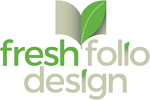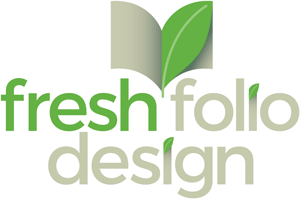Last week we introduced the importance of brochure design having a hierarchy. When a designer creates a hierarchy, they are organizing content for the reader so the message is clear and the overall tone of the brochure is consistent with that message.
We shared how using a grid in your design establishes a good foundation for creating hierarchy, and that once you have a grid there are elements designers work with to help execute the tone of the piece. These are not physical elements like line or shape, but rather concepts or principles that create a memorable acronym.
Good Design is CRAP (Contrast, Repetition, Alignment, Proximity)
We believe that design is not just pretty colors and pictures, but instead solves a problem. This week we are going to delve further into the elements of contrast, repetition, alignment, and proximity to help you recognize what is needed to take your design to the next level.
Each principle can stand on it’s own, however, they can also work together to create a specific tone for your design. Before we get too far ahead of ourselves, let’s review each principle and examine simplified visuals to further explain the concepts.
Contrast: Contrast is all about a difference in shape, color, size or texture. Now, within this concept you have elements that could be either low or high contrast. If you wanted to show that two things are different but still share qualities you would want to establish low contrast. High contrast, by comparison, is more dramatic and extreme. The purpose of high contrast is to create tension or grab the viewers attention.
Repetition: To repeat something is to give it emphasis. When used effectively, repetition can bring visual harmony and strengthen a design. However, if used for evil, or too much, it can either become overwhelming or bland. (Like an albino polar bear standing on a glacier in a blizzard.) Remember, to repeat something is to give it emphasis.
 Alignment: Alignment refers to how elements are organized. They can be aligned to the left, right, centered, top or bottom. Additionally, there can be a notable repetitive element in a design concept that can be used for alignment purposes. Aligning the elements on the page ties closely to the grid that the designer creates. The challenge with aligning is that there can be a fine line between creating visual order and making a page feel static and boring.
Alignment: Alignment refers to how elements are organized. They can be aligned to the left, right, centered, top or bottom. Additionally, there can be a notable repetitive element in a design concept that can be used for alignment purposes. Aligning the elements on the page ties closely to the grid that the designer creates. The challenge with aligning is that there can be a fine line between creating visual order and making a page feel static and boring.
Proximity: This relates to how elements are grouped together. When you have elements close to each other they can create a “visual unit” to the reader. For example, on a business card you will usually see the person’s name close to their job title. Proximity is essential to helping a reader understand content and establish relationship between different elements. The use of proximity is closely tied to “white space” (this refers to space that is blank, not the literal color of the space). Wherever content is not present, there will be “white space”; a designer needs to know how to use that space to create a visual resting place for the reader, but not feel like there are gaping holes in the design or that something is missing.
We created a handy-dandy graphic that illustrates these principles which you can download for free. (who doesn’t love getting free stuff?)
Enough Talk…Let’s See C.R.A.P. in Action
Now that we have a better understanding of what these principles mean, let’s see how they work in a real-life example. These concepts are simple but once you see them applied in a design you may get a better understanding of how effective they can be in creating strong design solutions.
Here is a spread from a brochure that we had created for a financial investment company. While their business dealt with finances (which can be a dry topic) their mission was helping churches to know how to invest more wisely so they could better serve the people attending the church. Therefore, they really wanted the brochure to reflect warmth and strong human connection.
At first glance, you may see the page as a simple eye-pleasing spread from a brochure. However, there is so much more going on. Let’s do a deeper dive to uncover how these “CRAP” principles are working.
We’ve highlighted the places in the attached sample spread where each of the four principles are at work. Starting on the left we see how contrast was used to create a dropcap for the introductory column of text.
Dropcaps are enlarged letters that identify where the reader should start reading. Sometimes the dropcap is a part of the body copy, even at it’s larger size. However, in this example it is used as a graphic element and is placed behind the body copy.
Next, we see how alignment was used for the columns of text. All three columns of text are aligned on the left side of the column, which is common in standard body text.
BONUS TIP: Type that is aligned to the left is called “left justified.” Type aligned to the right is referred to as “right justified.” So, does that mean centered text is called “center justified?” No silly goose, it’s just called “centered.”
On the right side of the page we see a series of piggy bank images repeated across the bottom of the page. Imagine how different that page would look if it was only one image. What we have created is a playful path of piggy banks that subtly suggests the idea of connection and community.
Finally, at the bottom right we see an example of proximity. To bring even more warmth to the design we used a handwritten font as a callout on the spread. The proximity of the verse and it’s corresponding reference help to identify it as one visual unit. Without even thinking about it the reader understands that content should all be read together.
As we have demonstrated, these principles are essential to a well-designed brochure. However, we would go even further to say that the design professional can harness the power of these principles and use them simultaneously. Let’s take one more look at this design to see a place where all 4 design principles are working together.
Looking at the images of the piggy banks, we have already identified the principle of repetition. Additionally, we can see how contrast was used through differentiation in the color of each piggy bank. Referencing our earlier description of high contrast versus low contrast, this color palette would also be an example of low contrast.
The positioning of all the images in the lower corner of the page creating a curvy line is utilizing the principle of proximity. And finally, the alignment of the piggy banks of head-to-tail creates movement across the page.
Hopefully, breaking down this design to identify the principles in action has given you better understanding of how design makes a difference. In addition to seeing how professional designers can use these tools to solve problems and more effectively communicate your message.











Leave a Reply